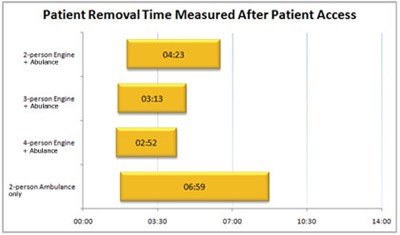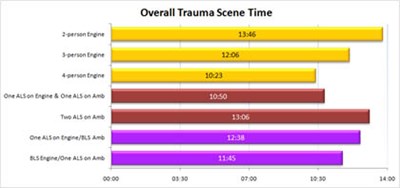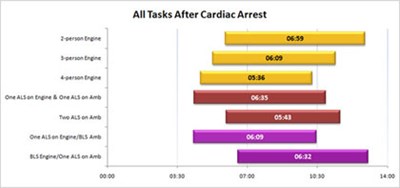The patient removal results show substantial differences associated with crew size. Crews with two-person first responder crews completed patient removal between (1.2 – 1.5) minutes slower than larger crews, depending on crew size. This is largely the result of work load in carrying equipment, supplies and the patient with fewer crew members. All crews with first responders completed removal substantially faster (by 2.6 min.-4.1 min.) relative to the ambulance-only crew. Again, this is largely the result of the difficulty of carrying and loading the patient, as well as the equipment and supplies with only a two-person crew, given that one person must remain with the patient at all times.
For the trauma scenario part of the experiments, there was an assumed three minute stagger in arrival between the first responder crew and the ambulance crew. Crews responding with one ALS provider on the engine and on the ambulance completed all trauma tasks 2.3 minutes (2 minutes and 16 seconds) faster than crews with a BLS engine and an ALS ambulance with two ALS level providers.
Crews responding with four-person first responder crews, regardless of ALS configuration, completed all trauma tasks 1.7 minutes (1 minute and 50 seconds) faster than first responder crews with three persons, and 3.4 minutes (3 minutes and 25 seconds) faster than first responder crews with two persons. This suggests that for trauma scenarios, the more hands available, the easier it is to implement the full portfolio of tasks to be completed.
Crews responding with four first responders, regardless of ALS configuration, completed all cardiac tasks from the “at patient time” 70 seconds faster than first responder crews with three persons, and two minutes and 40 seconds faster than first responder crews with two persons. Additionally, crews responding with one ALS provider on both the engine and ambulance completed all scene tasks from the “at patient time” 45 seconds sooner than crews with two ALS providers on the ambulance and a BLS engine. Crews responding with an ALS Engine and a BLS Ambulance completed tasks from “at patient time” two minutes 36 second sooner than crews with a BLS Engine and one ALS provider on the Ambulance.
[vc_single_image image=”49287″ img_size=”full”]


